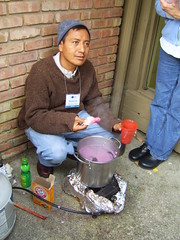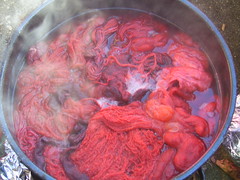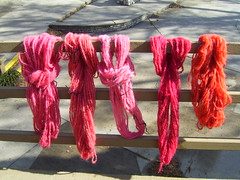Grrrr.
Our flight home was pretty smooth and uneventful. I like Aer Lingus, although they were not responsible for the strong tail winds that got us in about an hour early. And, mirabile dictu, as the DSM does not have to get himself in to work, he is not having sleeping difficulties, so I am not suffering the usual horrific "jet lag", merely a normal version thereof.
I am not as yet entirely sure how I am going to divide up the tale of the last few days of our trip. So, I shall first finish off SOAR details with the cochineal Retreat session.
What this did, basically, was turn my orthodoxy on to its head. Some of what I learned I shall definitely put in to practice, some of it not. I already knew that Demetrio used alum at 20%, which is double my amount; I don't think I shall emulate, especially as I am just as likely to use no mordant at all with cochineal. I think the fact that his textiles have to survive in Mexican sun is highly relevant, and Pennine greys will not require such stern measures!
But I was impressed with how he added his mordant to the pot (this for premordanting). The pot was brought to a boil, and the alum added dry directly to it - now, our received wisdom is to carefully mix the alum in a little hot water to dissolve it as much as possible first, which is always hard to achieve; I really do think that chucking it in to a pan at a rolling boil works better.
The other main difference is that the boiling continues - and I have always been very cautious and careful with reds as the orthodoxy is that too high a temperature will lead to brown shades. Very obviously not the case.
His additives were always baking soda and lime juice, and he is adamant that these are the best to use, but I am not so totally convinced about that. It is after all the ph that is the critical thing, no matter how obtained. He put the lime into the dyepot, and did the moderating with the alkaline afterwards - and back again, just because you can!
Pictures:

Demetrio tending his dyepot.

Cooking - close to a boil, anyway.

My very own sample skeins. I had taken some whitefaced woodland that I had already spun for natural dye projects, and I am really pleased with the results. I have around 100gms here, which should be enough for a small project.
The three skeins on the left as you look at the photo are from the three strengths of dyepot; the other two are done with the strongest pot, one alkaline, one acid. And they look just as nice now that I have them back home.
I really enjoyed this class; I learned quite a bit, and being in lovely sunshine with old friends didn't hurt any either. It's a nice memory to cherish, which is another reason to get a meaningful if small project out of the yarn samples.
We do have a lovely cochineal dyed rug we bought from him - I have yet to photograph it, but will get it up here eventually!
Anyway, that's about it for SOAR this year. Will we go again? We don't know yet. As it is in New England next year, we have a plan, but early days yet.
Next post will be, I think, on "visits". We made a few.

No comments:
Post a Comment